High-k Three-Phase Epoxy/K1.6(Ni0.8Ti7.2)O16/CNT Composites with Synergetic Effect
Abstract
:1. Introduction
2. Materials and Methods
3. Results and Discussion
4. Conclusions
Author Contributions
Funding
Institutional Review Board Statement
Informed Consent Statement
Data Availability Statement
Acknowledgments
Conflicts of Interest
References
- Ang, C.; Yu, Z.; Guo, R.; Bhalla, A.S. Calculation of dielectric constant and loss of two-phase composites. J. Appl. Phys. 2003, 93, 3475–3480. [Google Scholar] [CrossRef]
- Wang, S.; He, X.; Chen, Q.; Chen, Y.; He, W.; Zhou, G.; Zhang, H.; Jin, X.; Su, X. Graphene-coated copper calcium titanate to improve dielectric performance of PPO-based composite. Mater. Lett. 2018, 233, 355–358. [Google Scholar] [CrossRef]
- Mostovoi, A.S.; Plakunova, E.V.; Panova, L.G. New epoxy composites based on potassium polytitanates. Int. Polym. Sci. Technol. 2013, 40, 49–51. [Google Scholar]
- Chen, C.; Wang, L.; Liu, X.; Yang, W.; Lin, J.; Chen, G.; Yang, X. K0.5Na0.5NbO3-SrTiO3/PVDF polymer composite film with low remnant polarization and high discharge energy storage density. Polymers 2019, 11, 310. [Google Scholar] [CrossRef] [Green Version]
- Liu, M.; Ma, C.; Collins, G.; Liu, J.; Chen, C.; Dai, C.; Lin, Y.; Shui, L.; Xiang, F.; Wang, H.; et al. Interface engineered BaTiO3/SrTiO3 heterostructures with optimized high-frequency dielectric properties. ACS Appl. Mater. Interfaces 2012, 4, 5761–5765. [Google Scholar] [CrossRef]
- Bi, M.; Hao, Y.; Zhang, J.; Lei, M.; Bi, K. Particle size effect of BaTiO3 nanofillers on the energy storage performance of polymer nanocomposites. Nanoscale 2017, 9, 16386–16395. [Google Scholar] [CrossRef]
- Liu, P.; Ng, V.M.H.; Yao, Z.; Zhou, J.; Lei, Y.; Yang, Z.; Kong, L.B. Facile synthesis and hierarchical assembly of flowerlike NiO structures with enhanced dielectric and microwave absorption properties. ACS Appl. Mater. Interfaces 2017, 9, 16404–16416. [Google Scholar] [CrossRef]
- Hua, G.; Gao, F.; Kong, J.; Yang, S.; Zhang, Q.; Liu, Z.; Zhang, Y.; Sun, H. Preparation and dielectric properties of poly(vinylidene fluoride)/Ba0.6Sr0.4TiO3 composites. J. Alloys Compd. 2015, 619, 686–692. [Google Scholar]
- Dang, Z.-M.; Zhou, T.; Yao, S.-H.; Yuan, J.-K.; Zha, J.-W.; Song, H.-T.; Li, J.-Y.; Chen, Q.; Yang, W.-T.; Bai, J. Advanced calcium copper titanate/polyimide functional hybrid films with high dielectric permittivity. Adv. Mater. 2009, 21, 2077–2082. [Google Scholar] [CrossRef]
- Feng, Y.; Li, M.L.; Li, W.L.; Zhang, T.D.; Zhao, Y.; Fei, W.D. Polymer/metal multi-layers structured composites: A route to high dielectric constant and suppressed dielectric loss. Appl. Phys. Lett. 2018, 112, 022901. [Google Scholar] [CrossRef]
- Qi, L.; Lee, B.I.; Chen, S.; Samuels, W.D.; Exarhos, G.J. High-dielectric-constant silver–epoxy composites as embedded dielectrics. Adv. Mater. 2005, 17, 1777–1781. [Google Scholar] [CrossRef]
- Lu, J.; Moon, K.S.; Xu, J.; Wong, C.P. Synthesis and dielectric properties of novel high-K polymer composites containing in-situ formed silver nanoparticles for embedded capacitor applications. J. Mater. Chem. 2006, 16, 1543–1548. [Google Scholar] [CrossRef]
- Dang, Z.M.; Peng, B.; Xie, D.; Yao, S.H.; Jiang, M.J.; Bai, J. High dielectric permittivity silver/polyimide composite films with excellent thermal stability. Appl. Phys. Lett. 2008, 92, 112910. [Google Scholar] [CrossRef]
- Li, Y.J.; Xu, M.; Feng, J.Q.; Dang, Z.M. Dielectric behavior of a metal-polymer composite with low percolation threshold. Appl. Phys. Lett. 2006, 89, 072902. [Google Scholar] [CrossRef] [Green Version]
- Mostovoy, A.; Yakovlev, A.; Tseluikin, V.; Lopukhova, M. Epoxy Nanocomposites Reinforced with Functionalized Carbon Nanotubes. Polymers 2020, 12, 1816. [Google Scholar] [CrossRef]
- Liu, P.; Yao, Z.; Zhou, J. Mechanical, thermal and dielectric properties of graphene oxide/polyimide resin composite. High Perform. Polym. 2016, 28, 1033–1042. [Google Scholar] [CrossRef]
- He, F.; Sarkar, M.; Lau, S.; Fan, J.; Chan, L.H. Preparation and characterization of porous poly(vinylidene fluoride-trifluoroethylene) copolymer membranes via electrospinning and further hot pressing. Polym. Test. 2011, 30, 436–441. [Google Scholar] [CrossRef]
- Liu, P.; Yao, Z.; Zhou, J.; Yang, Z.; Kong, L.B. Small magnetic Co-doped NiZn ferrite/graphene nanocomposites and their dual-region microwave absorption performance. J. Mater. Chem. C 2016, 4, 9738–9749. [Google Scholar] [CrossRef]
- Yao, S.H.; Dang, Z.M.; Jiang, M.J.; Bai, J. BaTiO3-carbon nanotube/polyvinylidene fluoride three-phase composites with high dielectric constant and low dielectric loss. Appl. Phys. Lett. 2008, 93, 182905. [Google Scholar] [CrossRef]
- Dang, Z.M.; Shen, Y.; Nan, C.W. Dielectric behavior of three-phase percolative Ni–BaTiO3/polyvinylidene fluoride composites. Appl. Phys. Lett. 2002, 81, 4814–4816. [Google Scholar] [CrossRef]
- Bai, Y.; Cheng, Z.Y.; Bharti, V.; Xu, H.S.; Zhang, Q.M. High-dielectric-constant ceramic-powder polymer composites. Appl. Phys. Lett. 2000, 76, 3804–3806. [Google Scholar] [CrossRef]
- Bobnar, V.; Levstik, A.; Huang, C.; Zhang, Q.M. Dielectric properties and charge transport in all-organic relaxorlike CuPc-P (VDF-TrFE-CFE) composite and its constituents. Ferroelectrics 2006, 338, 107–116. [Google Scholar] [CrossRef]
- Wang, C.C.; Song, J.F.; Bao, H.M.; Shen, Q.D.; Yang, C.Z. Enhancement of electrical properties of ferroelectric polymers by polyaniline nanofibers with controllable conductivities. Adv. Funct. Mater. 2008, 18, 1299–1306. [Google Scholar] [CrossRef]
- Yuan, J.K.; Dang, Z.M.; Bai, J. Unique dielectric properties in polyaniline/poly(vinylidene fluoride) composites induced by temperature variation. Phys. Status Solidi (RRL)–Rapid Res. Lett. 2008, 2, 233–235. [Google Scholar] [CrossRef]
- Yuan, J.K.; Dang, Z.M.; Yao, S.H.; Zha, J.W.; Zhou, T.; Li, S.T.; Bai, J. Fabrication and dielectric properties of advanced high permittivity polyaniline/poly(vinylidene fluoride) nanohybrid films with high energy storage density. J. Mater. Chem. 2010, 20, 2441–2447. [Google Scholar] [CrossRef]
- Dang, Z.M.; Yuan, J.K.; Zha, J.W.; Zhou, T.; Li, S.T.; Hu, G.H. Fundamentals, processes and applications of high-permittivity polymer–matrix composites. Prog. Mater. Sci. 2012, 57, 660–723. [Google Scholar] [CrossRef]
- Poh, C.L.; Mariatti, M.; Noor, A.F.M.; Sidek, O.; Chuah, T.P.; Chow, S.C. Dielectric properties of surface treated multi-walled carbon nanotube/epoxy thin film composites. Compos. Part B 2016, 85, 50–58. [Google Scholar] [CrossRef]
- Drakopoulos, S.X.; Patsidis, A.C.; Psarras, G.C. Epoxy-based/BaTiO3 nanodielectrics: Relaxation dynamics, charge transport and energy storage. Mater. Res. Bull. 2022, 145, 111537. [Google Scholar] [CrossRef]
- Shalygina, T.A.; Melezhik, A.V.; Tkachev, A.G.; Voronina, S.Y.; Voronchikhin, V.D.; Vlasov, A.Y. The Synergistic Effect of a Hybrid Filler Based on Graphene Nanoplates and Multiwalled Nanotubes for Increasing the Thermal Conductivity of an Epoxy Composite. Tech. Phys. Lett. 2021, 47, 317–320. [Google Scholar]
- Kumar, A.; Saini, S.; Yadav, K.L.; Ghosh, P.K.; Rathi, A. Morphology and tensile performance of MWCNT/TiO2-epoxy nanocomposite. Mater. Chem. Phys. 2022, 277, 125336. [Google Scholar]
- Meisak, D.; Macutkevic, J.; Plyushch, A.; Kuzhir, P.; Selskis, A.; Banys, J. Dielectric relaxation in the Hybrid Epoxy/MWCNT/MnFe2O4 composites. Polymers 2020, 12, 697. [Google Scholar] [CrossRef] [Green Version]
- Gorshkov, N.; Goffman, V.; Vikulova, M.; Burmistrov, I.; Sleptsov, V.; Gorokhovsky, A. Polytetrafluorethylene-based high-k composites with low dielectric loss filled with priderite (K1.46Ti7.2Fe0.8O16). J. Appl. Polym. Sci. 2020, 137, 48762. [Google Scholar] [CrossRef]
- Gorshkov, N.V.; Goffman, V.G.; Vikulova, M.A.; Burmistrov, I.N.; Kovnev, A.V.; Gorokhovsky, A.V. Dielectric properties of the polymer–matrix composites based on the system of Co-modified potassium titanate–polytetrafluorethylene. J. Compos. Mater. 2018, 52, 135–144. [Google Scholar] [CrossRef]
- Vikulova, M.; Tsyganov, A.; Bainyashev, A.; Artyukhov, D.; Gorokhovsky, A.; Muratov, D.; Gorshkov, N. Dielectric properties of PMMA/KCTO(H) composites for electronics components. J. Appl. Polym. Sci. 2021, 138, 51168. [Google Scholar] [CrossRef]
- Gorokhovsky, A.V.; Tretyachenko, E.V.; Goffman, V.G.; Gorshkov, N.V.; Fedorov, F.S.; Sevryugin, A.V. Preparation and dielectric properties of ceramics based on mixed potassium titanates with the hollandite structure. Inorg. Mater. 2016, 52, 587–592. [Google Scholar] [CrossRef]
- Gorshkov, N.; Vikulova, M.; Gorbunov, M.; Mikhailova, D.; Burmistrov, I.; Kiselev, N.; Artyukhov, D.; Gorokhovsky, A. Synthesis of the hollandite-like copper doped potassium titanate high-k ceramics. Ceram. Int. 2021, 47, 5721–5729. [Google Scholar] [CrossRef]
- Kim, S.H.; Mulholland, G.W.; Zachariah, M.R. Density measurement of size selected multiwalled carbon nanotubes by mobility-mass characterization. Carbon 2009, 47, 1297–1302. [Google Scholar] [CrossRef]
- Moetakef, P.; Larson, A.M.; Hodges, B.C.; Zavalij, P.; Gaskell, K.J.; Piccoli, P.M.; Rodriguez, E.E. Synthesis and crystal chemistry of microporous titanates Kx(Ti, M)8O16 where M= Sc–Ni. J. Solid State Chem. 2014, 220, 45–53. [Google Scholar] [CrossRef]
- Besprozvannykh, N.V.; Sinel’shchikova, O.Y.; Morozov, N.A.; Kuchaeva, S.K.; Postnov, A.Y. Synthesis and Physicochemical Properties of Complex Oxides K2MexTi8–xO16 (Me = Mg, Ni, Al) of Hollandite Structure. Russ. J. Appl. Chem. 2020, 93, 1132–1138. [Google Scholar] [CrossRef]
- Morozov, N.A.; Sinelshchikova, O.Y.; Besprozvannykh, N.V.; Ugolkov, V.L. Citrate-Nitrate Synthesis and the Electrophysical Properties of Ceramics in the K2O–TiO2–Fe2O3 System. Glass Phys. Chem. 2021, 47, 481–488. [Google Scholar] [CrossRef]
- Lu, X.; Zhang, A.; Dubrunfaut, O.; He, D.; Pichon, L.; Bai, J. Numerical modeling and experimental characterization of the AC conductivity and dielectric properties of CNT/polymer nanocomposites. Compos. Sci. Technol. 2020, 194, 108150. [Google Scholar] [CrossRef]
- Sreejivungsa, K.; Phromviyo, N.; Swatsitang, E.; Thongbai, P. Characterizations and Significantly Enhanced Dielectric Properties of PVDF Polymer Nanocomposites by Incorporating Gold Nanoparticles Deposited on BaTiO3 Nanoparticles. Polymers 2021, 13, 4144. [Google Scholar] [CrossRef] [PubMed]
- Guan, S.; Li, H.; Zhao, S.; Guo, L. Novel three-component nanocomposites with high dielectric permittivity and low dielectric loss co-filled by carboxyl-functionalized multi-walled nanotube and BaTiO3. Compos. Sci. Technol. 2018, 158, 79–85. [Google Scholar] [CrossRef]
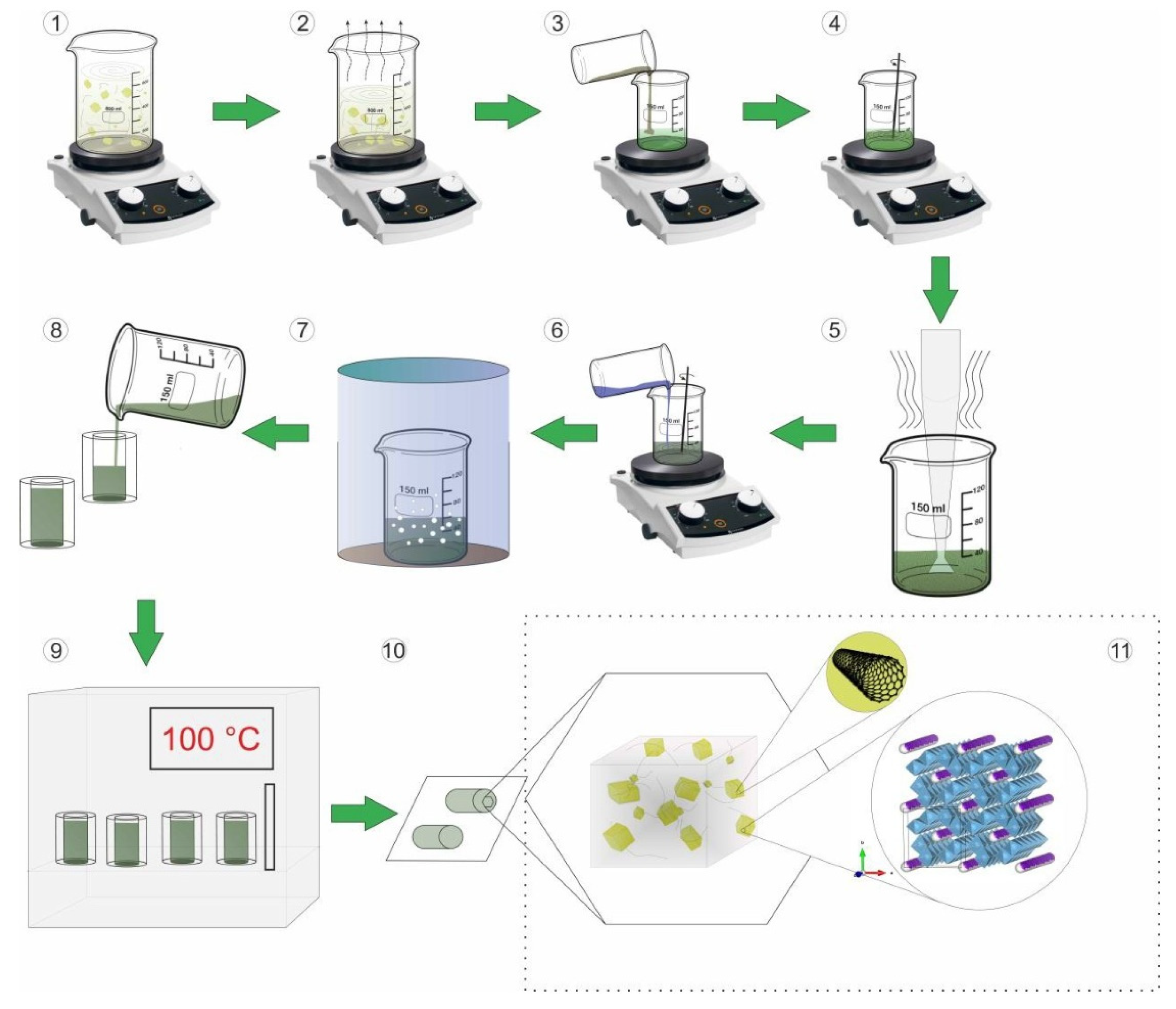
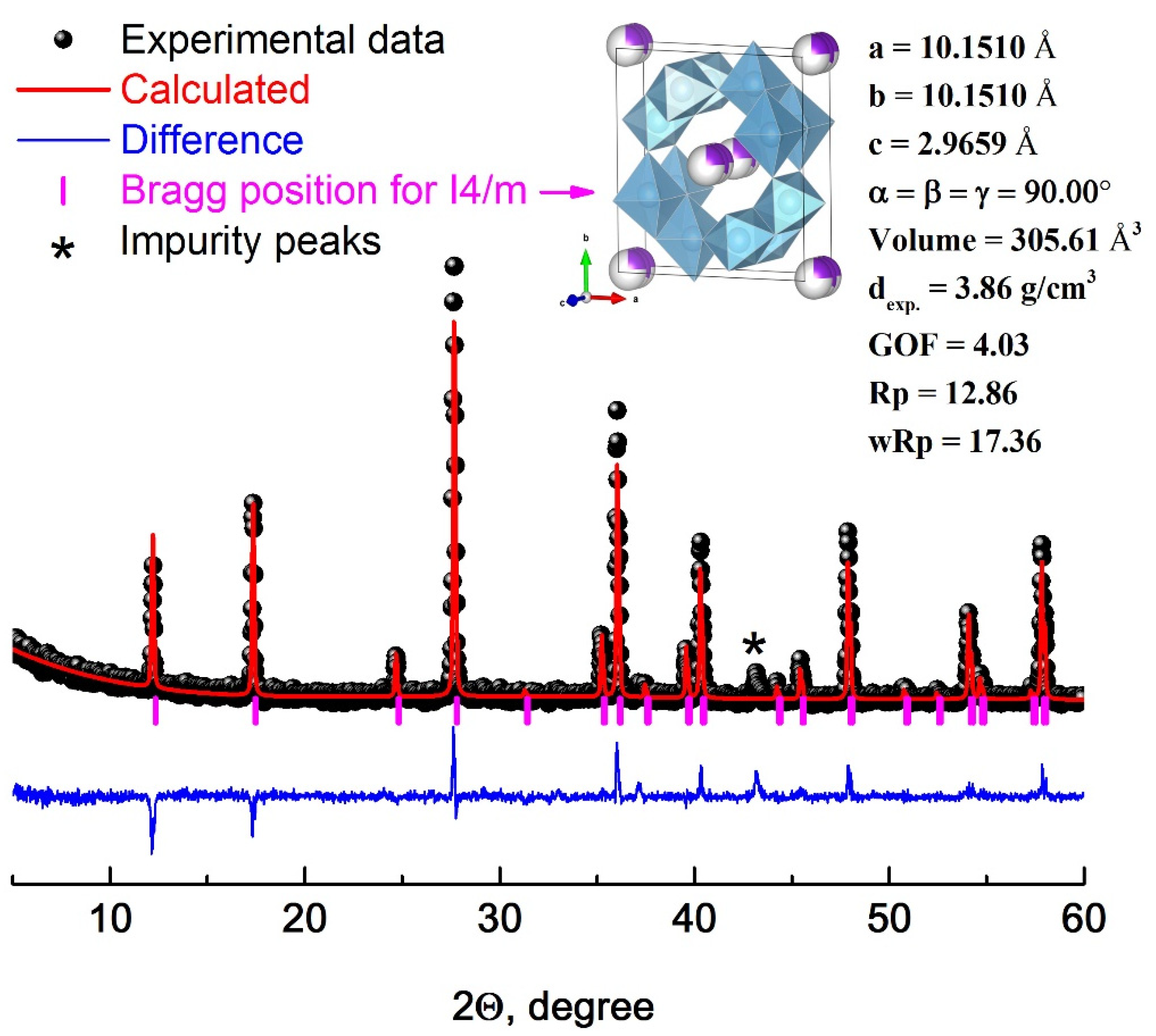

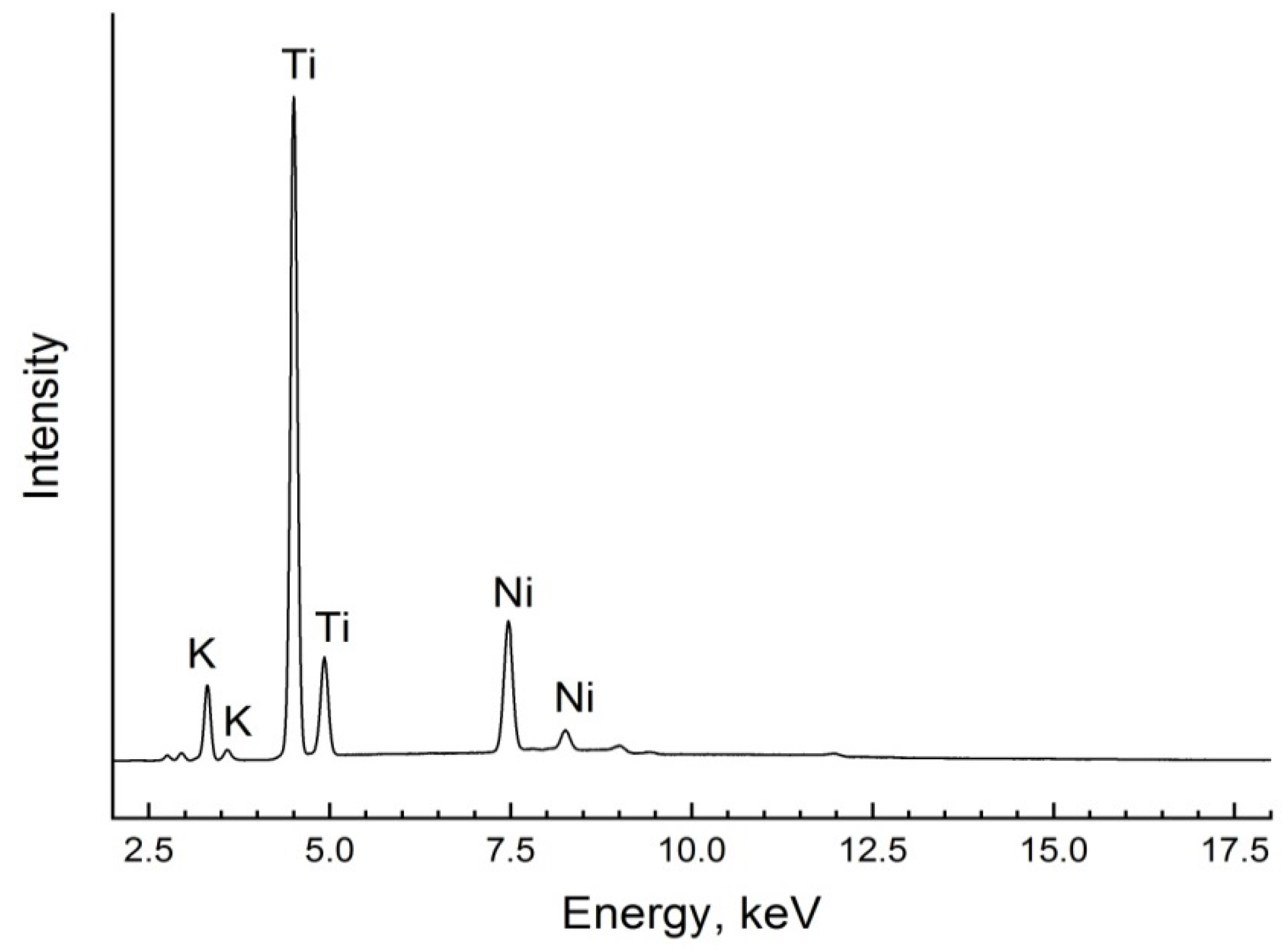
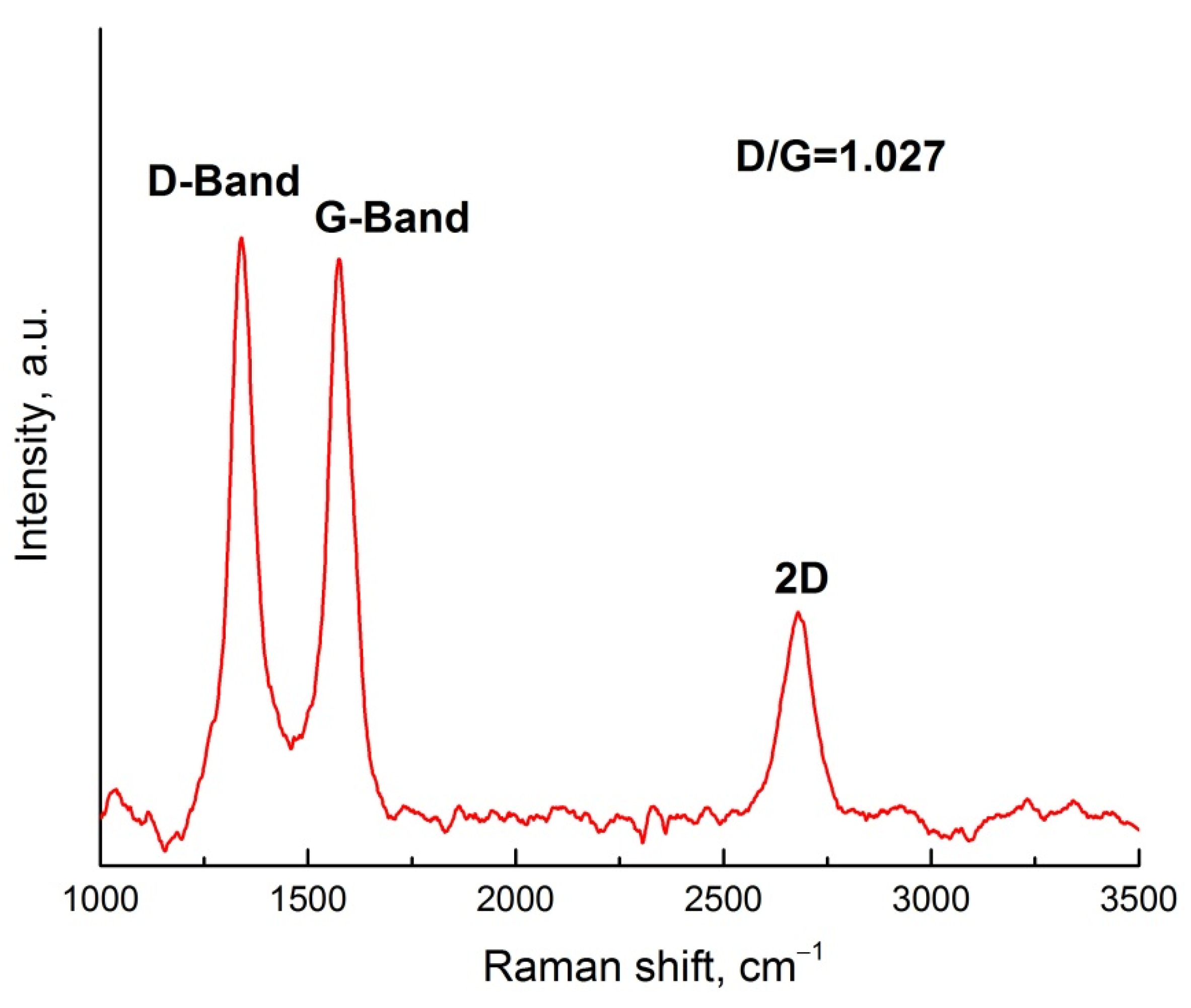
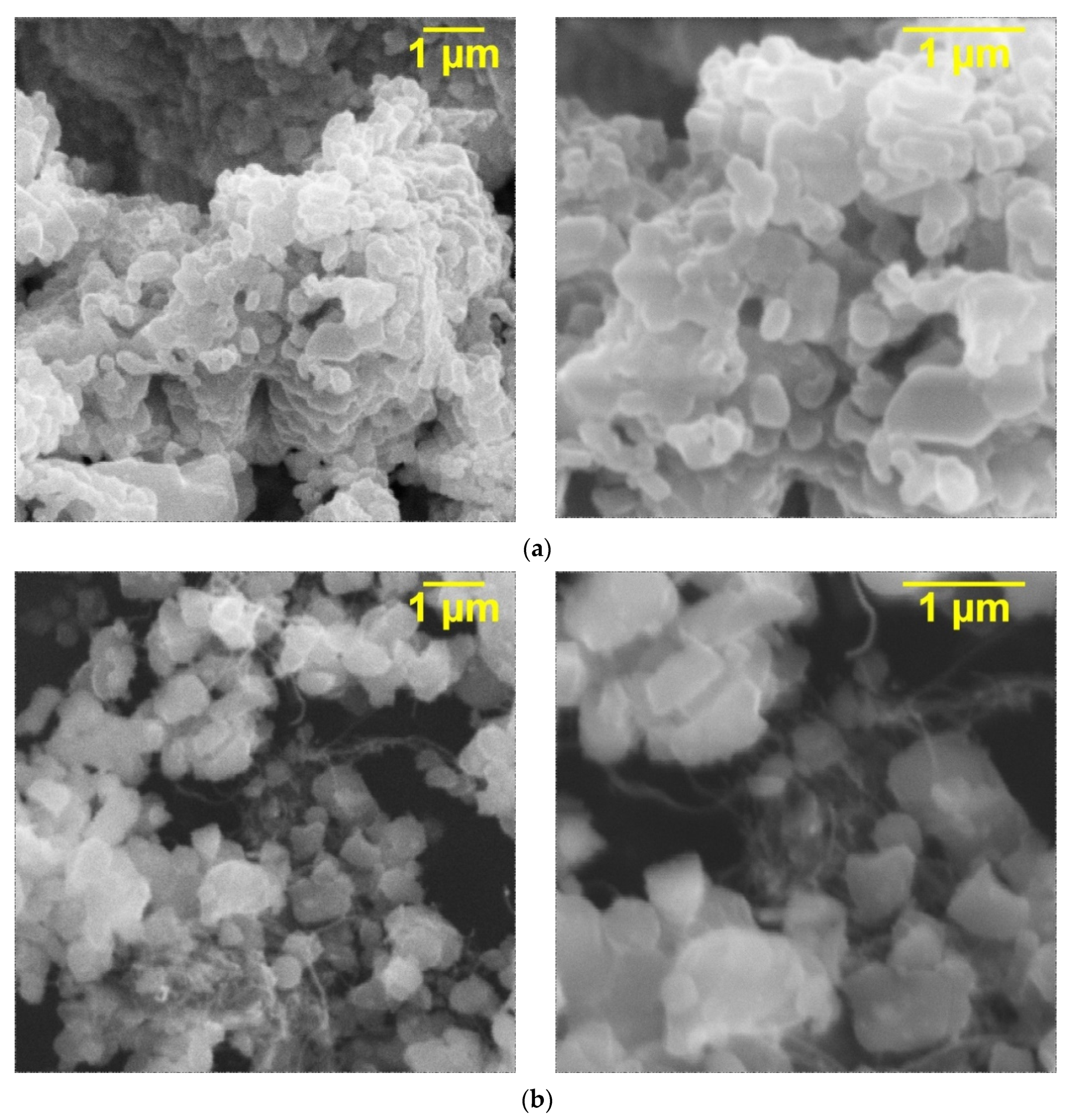

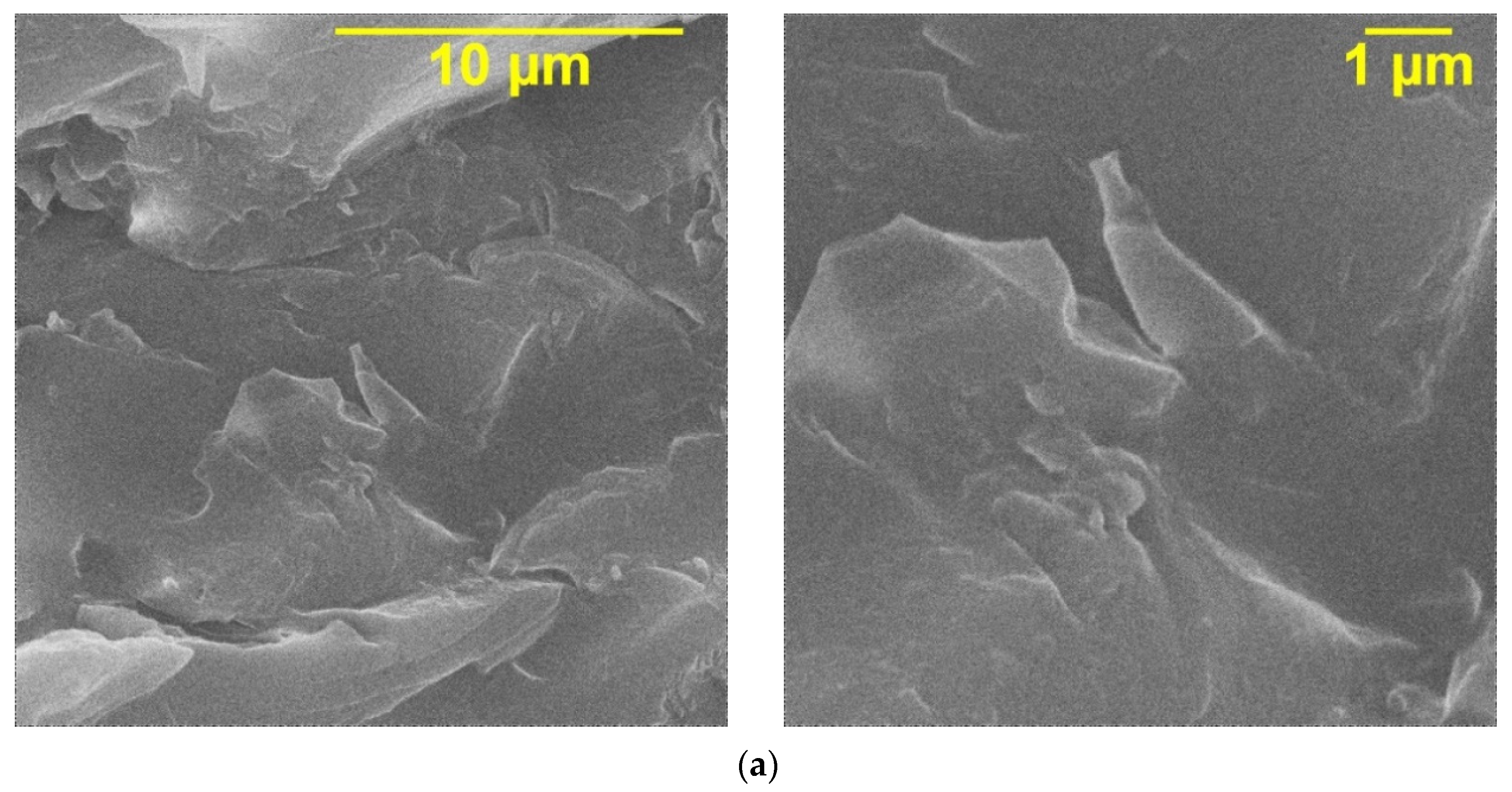

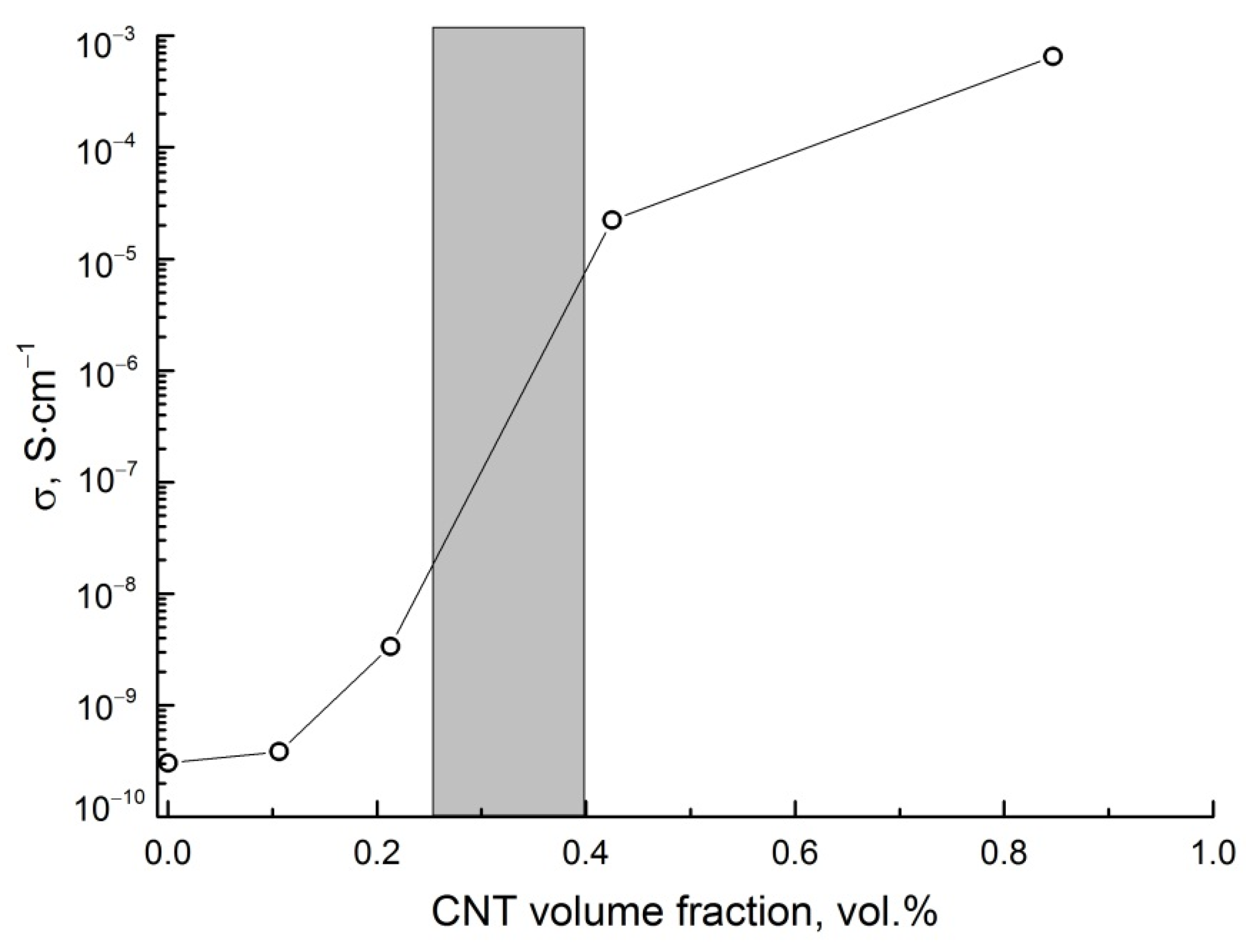

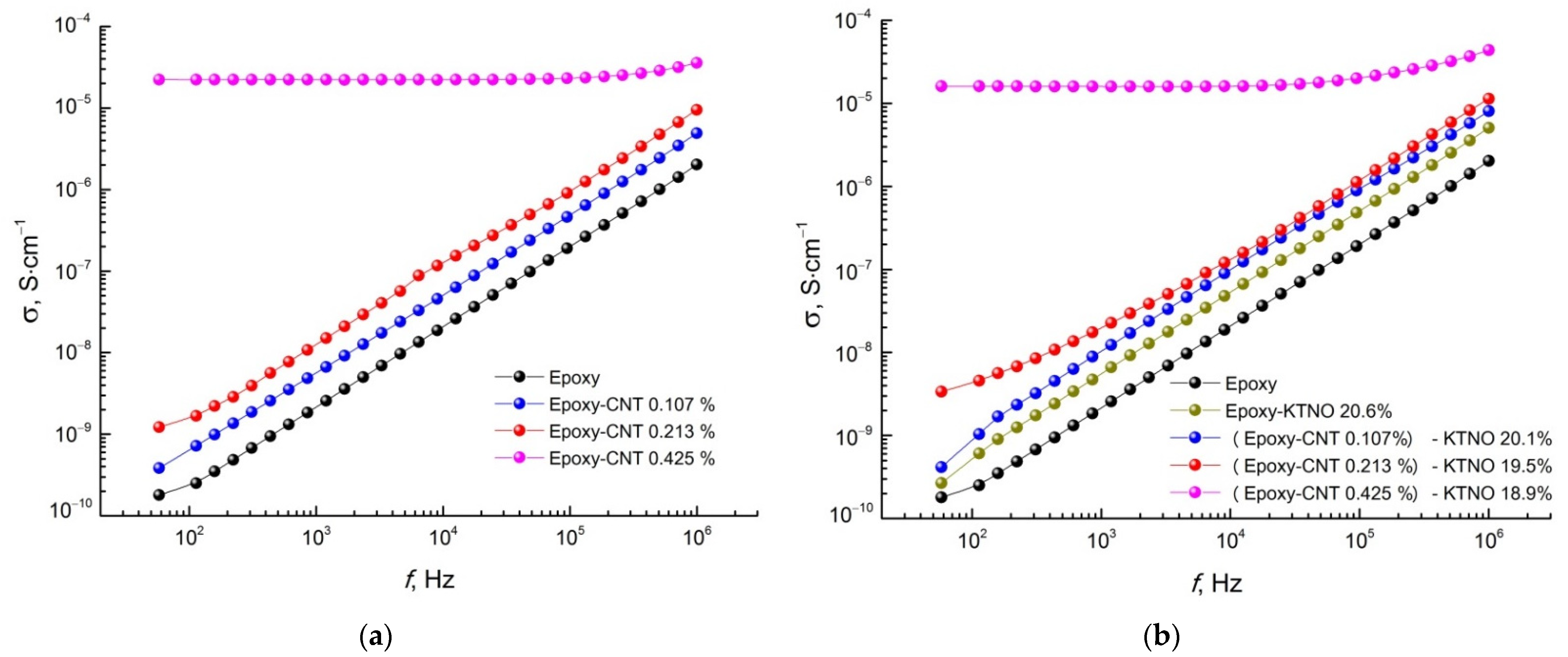
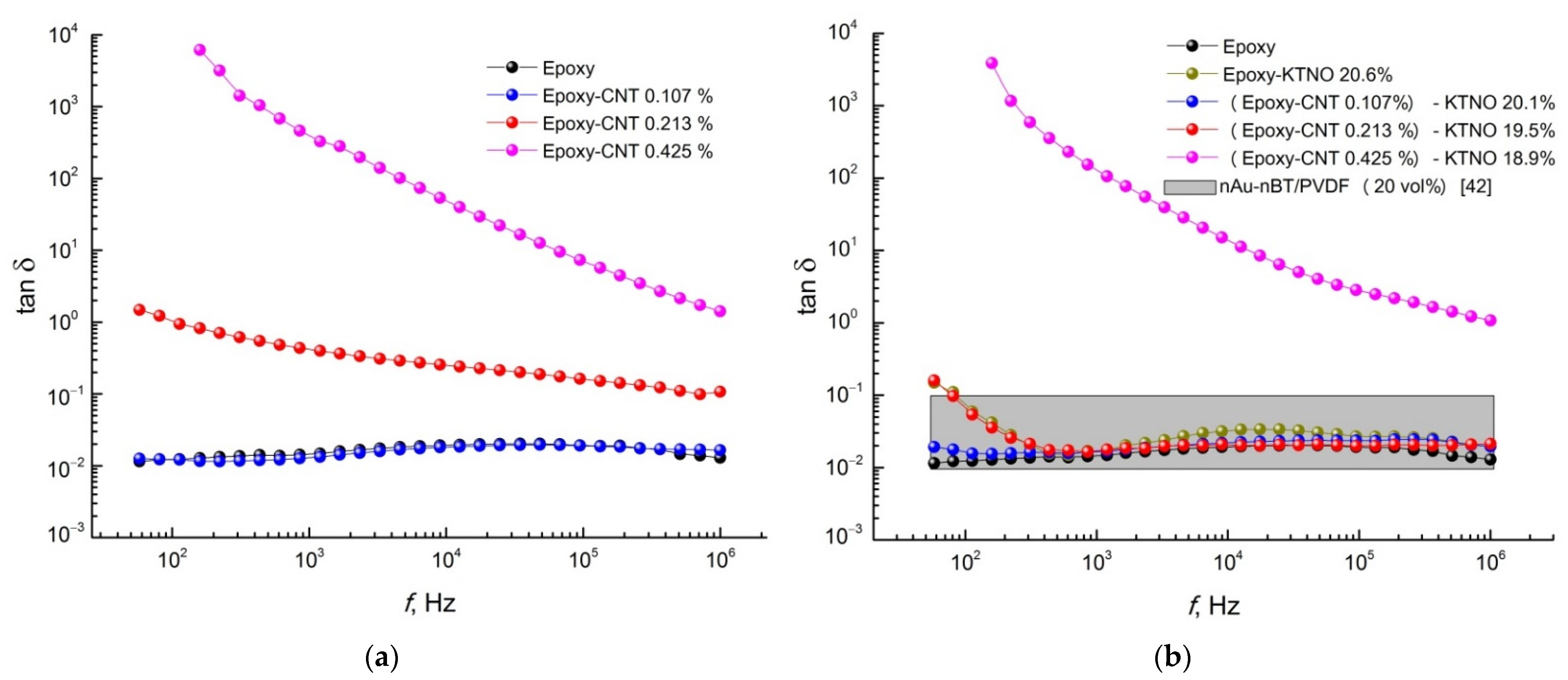
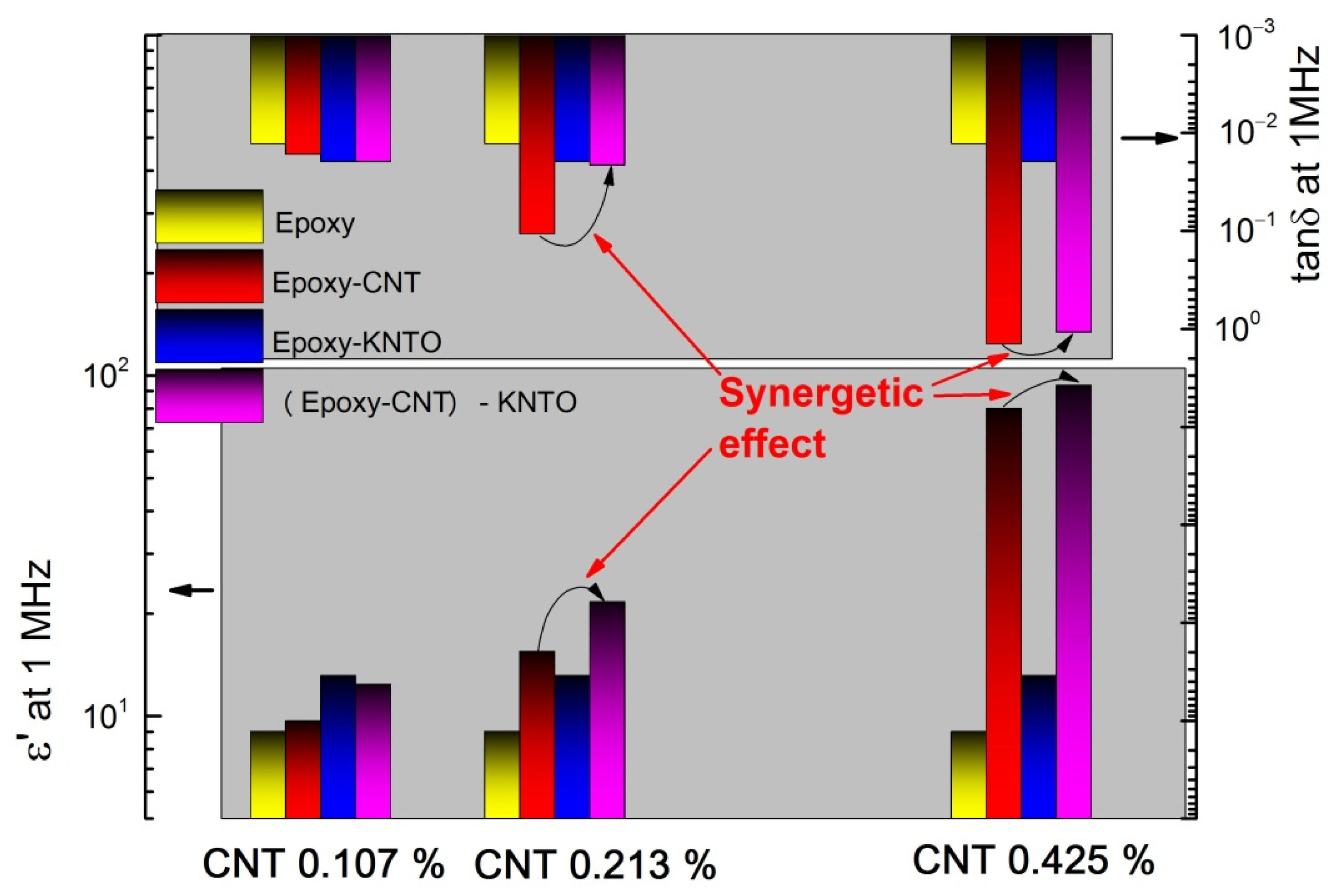
| Characteristics | Value |
|---|---|
| ED-20 | |
| Content of epoxy groups, % | 20.0–22.5 |
| Viscosity, Pa∙s | 13–20 |
| Epoxy equivalent, g/mol | 195–216 |
| Density at 25 °C, kg/m3 | 1166 |
| TETA | |
| Molecular mass, g/mol | 230–250 |
| Viscosity, Pa∙s | 0.60–0.90 |
| Density at 25 °C, kg/m3 | 1020 |
| Amine number, mg KOH/g | 1250 |
| Nitrogen content, % by weight | 30.0 |
| Initial Components | Component Content in Composites, vol.% | |||
|---|---|---|---|---|
| Full Name | Short Name | |||
| Epoxy resin | Epoxy | |||
| K1.6(Ni0.8Ti7.2)O16 | KNTO | 20.1 | 19.5 | 18.9 |
| Carbon nanotube | CNT | 0.107 | 0.213 | 0.425 |
| ED-20 | KNTO | CNT | ||
|---|---|---|---|---|
| 20.6 | Epoxy-KNTO | 0.107 | (Epoxy-CNT 0.107%)-KNTO 20.1% | |
| 0.213 | (Epoxy-CNT 0.213%)-KNTO 19.5% | |||
| 0.425 | (Epoxy-CNT 0.425%)-KNTO 18.9% | |||
| ED-20 | CNT | |||
| 0.107 | Epoxy-CNT 0.107% | |||
| 0.213 | Epoxy-CNT 0.213% | |||
| 0.425 | Epoxy-CNT 0.425% |
Publisher’s Note: MDPI stays neutral with regard to jurisdictional claims in published maps and institutional affiliations. |
© 2022 by the authors. Licensee MDPI, Basel, Switzerland. This article is an open access article distributed under the terms and conditions of the Creative Commons Attribution (CC BY) license (https://creativecommons.org/licenses/by/4.0/).
Share and Cite
Vikulova, M.; Nikityuk, T.; Artyukhov, D.; Tsyganov, A.; Bainyashev, A.; Burmistrov, I.; Gorshkov, N. High-k Three-Phase Epoxy/K1.6(Ni0.8Ti7.2)O16/CNT Composites with Synergetic Effect. Polymers 2022, 14, 448. https://doi.org/10.3390/polym14030448
Vikulova M, Nikityuk T, Artyukhov D, Tsyganov A, Bainyashev A, Burmistrov I, Gorshkov N. High-k Three-Phase Epoxy/K1.6(Ni0.8Ti7.2)O16/CNT Composites with Synergetic Effect. Polymers. 2022; 14(3):448. https://doi.org/10.3390/polym14030448
Chicago/Turabian StyleVikulova, Maria, Tatyana Nikityuk, Denis Artyukhov, Alexey Tsyganov, Alexey Bainyashev, Igor Burmistrov, and Nikolay Gorshkov. 2022. "High-k Three-Phase Epoxy/K1.6(Ni0.8Ti7.2)O16/CNT Composites with Synergetic Effect" Polymers 14, no. 3: 448. https://doi.org/10.3390/polym14030448
APA StyleVikulova, M., Nikityuk, T., Artyukhov, D., Tsyganov, A., Bainyashev, A., Burmistrov, I., & Gorshkov, N. (2022). High-k Three-Phase Epoxy/K1.6(Ni0.8Ti7.2)O16/CNT Composites with Synergetic Effect. Polymers, 14(3), 448. https://doi.org/10.3390/polym14030448










